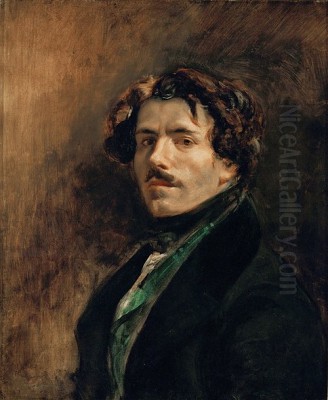
Ferdinand Victor Eugène Delacroix stands as a colossus in the annals of art history, the undisputed leader of the French Romantic school. Born at the cusp of a new century, on April 26, 1798, in Charenton-Saint-Maurice, France, his life and work embodied the turbulent spirit, passionate intensity, and revolutionary fervor of his era. Delacroix was more than a painter; he was a visual poet whose canvases pulsed with dramatic energy, vibrant color, and profound emotion. His rejection of the cool, restrained Neoclassicism that dominated French art paved the way for new modes of expression, influencing generations of artists and leaving an indelible mark on the trajectory of Western art. He passed away in Paris on August 13, 1863, leaving behind a legacy defined by artistic innovation and passionate intensity.
Early Life and Artistic Formation
Delacroix's origins were steeped in the political and social complexities of post-revolutionary France. Officially, his father was Charles-François Delacroix, a diplomat who served as Minister of Foreign Affairs under the Directory. However, persistent and widely discussed rumors suggested his biological father might have been the immensely influential statesman Charles Maurice de Talleyrand-Périgord, a family friend who later became a protector of the young artist. His mother, Victoire Oeben, descended from a line of skilled cabinet-makers. This blend of political connection and artisanal heritage perhaps foreshadowed the unique combination of intellectual depth and technical mastery in his later work.
Tragedy struck early. Charles Delacroix died in 1805, and Victoire followed in 1814, leaving the sixteen-year-old Eugène an orphan. Despite these hardships, his artistic inclinations were recognized and encouraged, notably by his uncle, the painter Henri-François Riesener (though the provided text mentions Charles-François, Riesener is the more commonly cited artistic relative who offered encouragement). Crucially, the support, whether paternal or merely patronly, of Talleyrand likely facilitated his education and entry into artistic circles. He received a solid classical education at the Lycée Impérial (now Lycée Louis-le-Grand).
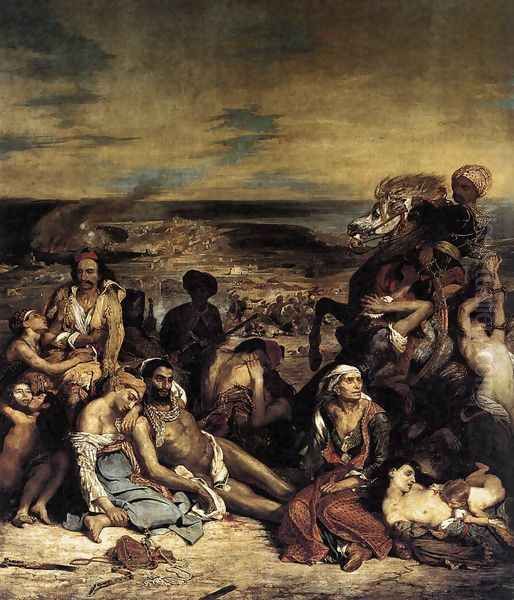
His formal art training began in 1815 when he entered the studio of the prominent Neoclassical painter Baron Pierre-Narcisse Guérin. Guérin's studio was a crucible of young talent, and it was here that Delacroix encountered Théodore Géricault, a slightly older artist whose dynamic style and dramatic subject matter, particularly his masterpiece The Raft of the Medusa, would profoundly impact Delacroix. While learning the fundamentals under Guérin, Delacroix was already drawn to the more expressive potential of painting, spending hours at the Louvre studying and copying the Old Masters, particularly Peter Paul Rubens and Paolo Veronese, whose rich colors and dynamic compositions resonated deeply with his burgeoning artistic temperament. He also admired the power and emotional depth of Michelangelo.
The Rise of a Romantic Leader
Delacroix's emergence coincided with the rise of Romanticism as a major cultural force across Europe. This movement, a reaction against the Enlightenment's emphasis on reason and the perceived rigidity of Neoclassicism, championed individualism, emotion, imagination, and the sublime power of nature. In painting, this translated into a preference for dramatic subjects drawn from history, literature, and contemporary events, rendered with expressive brushwork, rich color, and heightened emotional intensity.
His official debut at the Paris Salon of 1822 was sensational. The Barque of Dante (also known as Dante and Virgil in Hell), inspired by Dante Alighieri's Inferno, was a startling departure from the polished surfaces and static compositions favored by the Neoclassical establishment, led by figures like Jean-Auguste-Dominique Ingres. Delacroix's canvas depicted the poets Dante and Virgil crossing the River Styx, surrounded by tormented souls clinging to their boat. The painting's dark, turbulent atmosphere, muscular figures writhing in agony, and dramatic use of light and shadow announced the arrival of a powerful new voice. While some critics were shocked, the state purchased the painting, signaling a degree of official recognition.
Two years later, at the Salon of 1824, Delacroix solidified his position as a leader of the new school with The Massacre at Chios. This large-scale canvas depicted the horrific aftermath of a Turkish atrocity against the Greek population during the Greek War of Independence. Its unflinching portrayal of suffering, death, and despair, combined with its vibrant, almost jarring colors and loose brushwork, provoked outrage among conservative critics. Some famously decried it as "the massacre of painting." Yet, its raw emotional power and topical subject matter resonated with many, capturing the Romantic fascination with contemporary struggles for freedom and the plight of the oppressed. It established Delacroix as a painter unafraid to tackle difficult themes with visceral intensity.
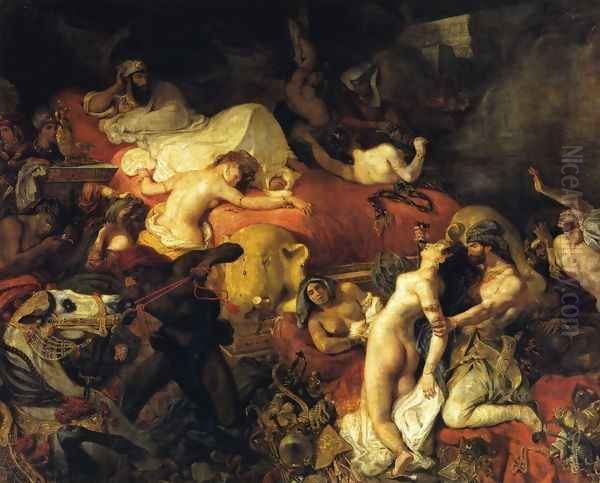
Throughout the 1820s, Delacroix continued to challenge artistic conventions. He developed a rivalry with Ingres, the standard-bearer of Neoclassicism. Their differing approaches represented the central artistic conflict of the era: Ingres championing line, clarity, and idealized form, while Delacroix prioritized color, emotion, and dynamic movement. Despite his revolutionary style, Delacroix himself sometimes expressed ambivalence about the "Romantic" label, reportedly seeing himself more in the lineage of the great classical masters, albeit reinterpreting their spirit rather than rigidly adhering to their forms.
Masterpieces and Major Themes
Delacroix's oeuvre is vast and varied, but several works stand out as defining masterpieces that encapsulate his artistic vision and the spirit of Romanticism.
The Death of Sardanapalus (1827): Inspired by a play by Lord Byron, this painting is perhaps Delacroix's most opulent and violent work. It depicts the last moments of the legendary Assyrian king Sardanapalus, who, facing defeat, orders the destruction of all his possessions – including his concubines, slaves, and horses – as he reclines impassively on a vast funeral pyre. The canvas explodes with color, movement, and raw sensuality amidst the carnage. Twisting bodies, luxurious fabrics, and gleaming treasures are rendered with energetic brushstrokes. It was highly controversial at the Salon of 1828 for its perceived glorification of cruelty and decadence, its chaotic composition, and its dramatic foreshortening, further cementing Delacroix's reputation as a radical innovator.
Liberty Leading the People (1830): Undoubtedly Delacroix's most famous painting, this iconic work commemorates the July Revolution of 1830, which toppled King Charles X. It is a powerful allegory of revolution, personified by the figure of Liberty, a bare-breasted woman embodying both classical goddess and woman of the people, holding the French Tricolour aloft and urging the diverse crowd forward over the barricades. Figures representing different social classes – the bourgeois in a top hat, the urban worker, a young student – unite under her banner. The painting combines realism in its depiction of the Parisian setting and the casualties of the fighting with powerful symbolism. Its dynamic composition, rich color, and emotional fervor made it an immediate symbol of French republicanism and the fight for freedom, a status it retains to this day. It hangs prominently in the Louvre Museum.
The Allure of the Exotic: The Journey to North Africa
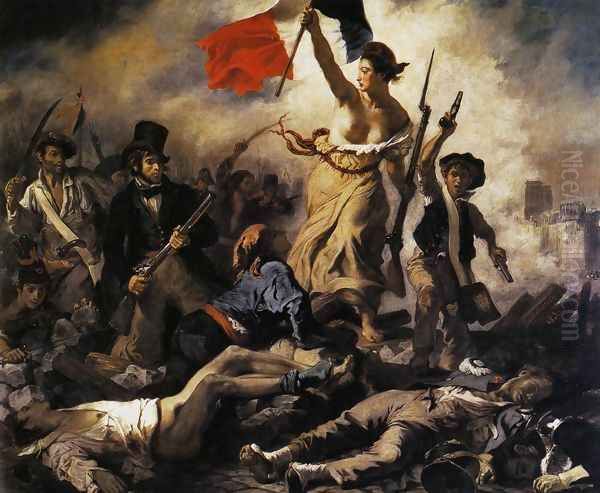
A pivotal moment in Delacroix's life and artistic development was his journey to Morocco and Algeria in 1832. He accompanied a diplomatic mission led by the Comte de Mornay, sent by King Louis-Philippe to the Sultan of Morocco. This trip provided Delacroix with firsthand exposure to a culture, landscape, and quality of light vastly different from anything he had known in Europe. He was captivated by the vibrant colors, the dignity and bearing of the people, the exotic costumes, and the intense North African light.
He filled sketchbooks with drawings and watercolors, documenting everything from street scenes and marketplaces to portraits, architectural details, and animal studies, particularly horses and big cats. This journey profoundly influenced his palette, leading him to use even brighter, more luminous colors, and it provided him with a rich source of subject matter for the rest of his career. Orientalism, the European fascination with the cultures of North Africa and the Middle East, was already a feature of Romanticism, but Delacroix's experience lent his Orientalist works an authenticity and intensity that set them apart.
Upon his return, he produced a series of major paintings based on his travels. The Women of Algiers in their Apartment (1834) is one of the most celebrated. Based on rare access he gained to a Muslim harem, it depicts several women reclining in a richly decorated interior. Unlike the often sensationalized or purely imagined harem scenes by other artists, Delacroix's painting conveys a sense of intimacy, quietude, and dignity. Its masterful handling of color, light filtering through the room, and textures of fabrics and carpets deeply impressed later artists, including Renoir and Picasso, who both created variations on the theme. Other notable works inspired by the trip include numerous scenes of Arab horsemen, lion hunts (Lion Hunt in Morocco, 1855), and portraits (Portrait of the Sultan of Morocco, 1862), all characterized by vibrant color and dynamic energy.
Color, Light, and Technique
Delacroix's handling of color was revolutionary. He moved away from the traditional academic practice of smoothly blended tones and local color, instead employing techniques that anticipated later movements like Impressionism. He understood the power of complementary colors (like red and green, or blue and orange) placed side-by-side to intensify each other, creating a visual vibration and brilliance. He often applied paint in visible, energetic brushstrokes, allowing the texture of the paint itself to contribute to the overall effect.
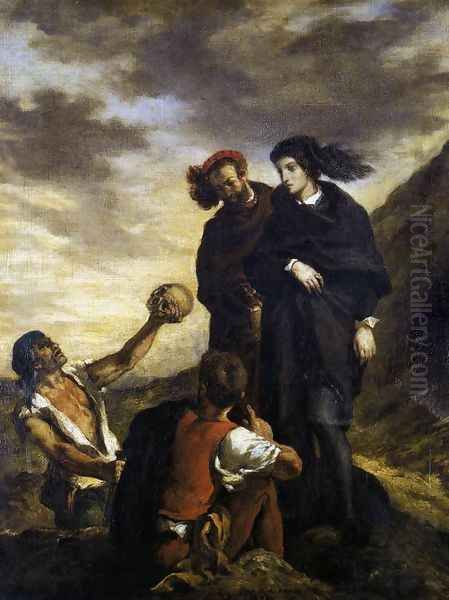
His study of optics and color theory, influenced partly by contemporary scientific research (like the work of Michel Eugène Chevreul, though the direct influence is debated), led him to experiment with "flochetage" – applying small dabs or strokes of different colors next to each other, allowing the viewer's eye to blend them optically. This technique added vibrancy and luminosity to his canvases. He masterfully used chiaroscuro (the contrast of light and dark) not just for modeling form, but for creating dramatic emphasis and emotional mood. His Journal, a detailed diary he kept for much of his life, contains numerous reflections on color, light, and technique, revealing a highly analytical mind alongside his passionate artistic temperament. He believed color was paramount for expressing emotion and creating atmosphere.
Literature, History, and Religion
Delacroix was a man of broad culture, deeply interested in literature, history, and music (he was close friends with composer Frédéric Chopin). His paintings often drew inspiration from literary giants like William Shakespeare, Lord Byron, Sir Walter Scott, Dante Alighieri, and Johann Wolfgang von Goethe. Works like Hamlet and Horatio in the Graveyard, The Bride of Abydos, and scenes from Goethe's Faust demonstrate his ability to translate the dramatic intensity and psychological depth of literary narratives into visual form. Medea About to Kill Her Children (1838) is another powerful example, capturing the terrifying moment from Greek mythology with raw emotion.
History, both ancient and contemporary, was another rich vein for his art. Beyond the Massacre at Chios and Liberty Leading the People, he depicted scenes from the Crusades and other historical episodes, always focusing on the human drama and emotional impact. His approach to history was not merely illustrative; it was interpretive, imbued with the Romantic sense of the past's grandeur, tragedy, and relevance to the present.
His relationship with religion was complex. While described as skeptical or agnostic in his personal beliefs, he produced numerous powerful religious paintings throughout his career. Works like Christ on the Mount of Olives (1824/27 versions), The Entombment of Christ, and large-scale mural commissions for churches like Saint-Sulpice in Paris (including Jacob Wrestling the Angel and Heliodorus Driven from the Temple, completed near the end of his life) are among his most profound creations. He approached these subjects not necessarily from a place of devout faith, but with a deep appreciation for their inherent drama, pathos, and potential for exploring universal human emotions like suffering, sacrifice, and spiritual struggle.
Personal Life, Personality, and Relationships
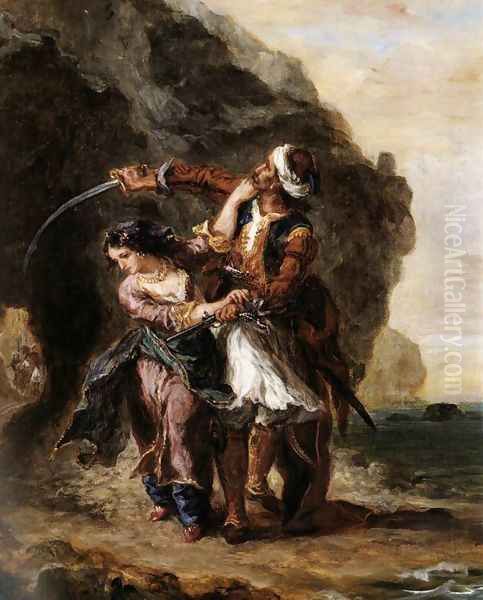
Delacroix cut a figure of intellectual intensity and passionate dedication to his art. He never married, a decision perhaps rooted in a desire to protect his creative independence or stemming from a certain Romantic melancholy and skepticism about domestic life. However, his life was not devoid of close relationships. He maintained a long and devoted association with his housekeeper, Jeanne-Marie "Jenny" Le Guillou, who joined his household in 1835 and remained his loyal companion, caregiver, and fierce protector of his privacy until his death. The exact nature of their relationship remains somewhat ambiguous, but her importance to his life is undeniable.
He formed significant friendships within the artistic and literary circles of Paris. He was close to the writer George Sand and her lover, the composer Frédéric Chopin, whose portrait Delacroix famously painted. He also maintained connections, sometimes complex, with fellow artists. His relationship with Ingres was marked by mutual respect mixed with profound artistic opposition, embodying the central aesthetic debate of their time. He admired the talent of his early influence, Géricault, whose premature death was a blow. He corresponded with figures like Victor Hugo, though their relationship could also be strained.
Delacroix's Journal, kept intermittently from 1822 to 1863, offers invaluable insights into his thoughts, working methods, aesthetic theories, and personal reflections. It reveals a highly intelligent, articulate, often critical, and sometimes melancholic personality, deeply engaged with the art of the past and present, literature, music, and the world around him. He suffered from recurring health problems, particularly respiratory issues (likely tuberculosis), especially in his later years. He sought refuge from the pressures of Paris at his country home in Champrosay, where he could work in relative peace. He died in his apartment on the Place de Fürstenberg in Paris, with Jenny Le Guillou by his side.
Legacy and Enduring Influence
Eugène Delacroix's impact on the course of art history is immense and multifaceted. As the foremost painter of French Romanticism, he fundamentally shifted artistic priorities away from the linear precision and idealized calm of Neoclassicism towards color, emotion, and dynamic expression. His work served as a crucial bridge between the traditions of the Old Masters (especially the colorists like Rubens and the Venetians) and the emergence of modern art.
His innovations in color theory and brushwork directly inspired the Impressionists. Artists like Claude Monet, Pierre-Auguste Renoir, and Camille Pissarro studied his use of complementary colors and broken brushstrokes to capture the effects of light and atmosphere. Edgar Degas acquired works by Delacroix, and Édouard Manet, a pivotal figure straddling Realism and Impressionism, deeply admired him.
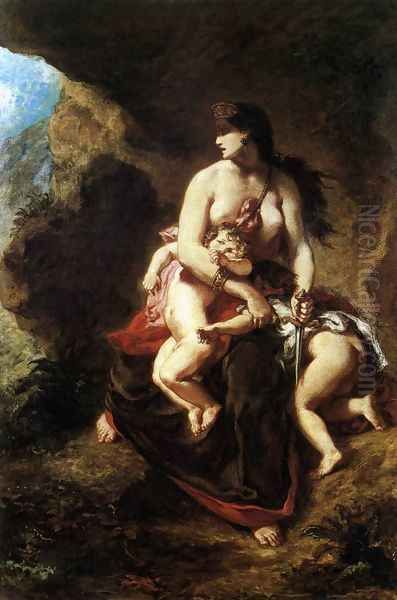
The Post-Impressionists also looked to Delacroix. Paul Cézanne famously declared, "We all paint in Delacroix's language," acknowledging his foundational importance for modern explorations of color and form. Vincent van Gogh copied Delacroix's works, drawn to their emotional intensity and vibrant palette. Paul Gauguin saw in Delacroix's exoticism and rich color a precursor to his own Symbolist explorations.
His influence extended into the 20th century. The Fauves, including Henri Matisse, admired his bold, non-naturalistic use of color. Pablo Picasso engaged directly with Delacroix's legacy, most notably creating a series of variations on The Women of Algiers. Delacroix's emphasis on personal expression and the power of the imagination resonated with Symbolist painters and later movements that prioritized subjective experience. His dramatic compositions and exploration of powerful themes also influenced academic and history painters throughout the 19th century.
Beyond specific stylistic influences, Delacroix redefined the image of the modern artist – passionate, individualistic, intellectually engaged, and constantly pushing boundaries. The preservation of his last studio in Paris as the Musée National Eugène Delacroix, thanks to the efforts of later artists like Maurice Denis and Paul Signac who formed the "Society of Friends of Eugène Delacroix," stands as a testament to his enduring importance.
Delacroix in Art History and Scholarship
Academic study of Delacroix continues to thrive. His position as the leader of French Romantic painting is undisputed, though scholarship continues to explore the nuances of his relationship with both Neoclassicism and his own "Romantic" label. His Journal and extensive correspondence remain primary sources for understanding his complex thoughts on art, life, and society.
Major exhibitions regularly reassess his work, bringing together masterpieces, drawings, prints, and contextual materials. Recent scholarship often takes an interdisciplinary approach, examining his work through the lenses of literature, history, politics, psychoanalysis, and post-colonial theory (particularly regarding his Orientalist works). Technical analyses continue to reveal the sophistication of his methods. Comprehensive monographs and catalogues raisonnés provide foundational resources for scholars and enthusiasts alike. While his initial reception was often marked by controversy, his status as a pivotal figure in the development of modern art is now firmly established globally.
Conclusion
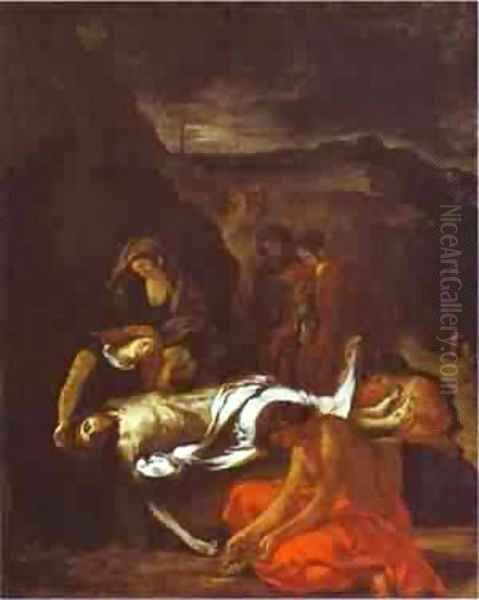
Eugène Delacroix was a force of nature in 19th-century art. He harnessed the turbulent energy of the Romantic era, translating its ideals of passion, freedom, and individualism into powerful visual statements. Through his revolutionary use of color, dynamic compositions, and exploration of profound human emotions drawn from literature, history, and the world around him, he broke the mold of academic art. His journey to North Africa opened new vistas in European painting, while his intellectual depth, revealed in his writings, adds another layer to his artistic persona. More than just the leader of a movement, Delacroix was a vital link in the chain of art history, deeply rooted in tradition yet boldly pointing the way towards modernity. His legacy endures not only in the canvases that blaze with color and emotion but also in the very spirit of artistic innovation and expressive freedom he championed.